

EXHIBITIONS
Sculpture-object
Venue
Nihonbashi/Bakurocho Area
Back alley of Nihonbashi Muromachi and Nihonbashi Honcho
1 Nihonbashi Muromachi / 1 Nihonbashi Honcho, Chuo-ku
Etoile Kaito Living Bldg.
1-15-15 Higashikanda, Chiyoda-ku
Date
Free
Sumiko Iwaoka’s work is on view at the Etoile Kaito Living Building (closed Mon–Tue, except hols; 11:30–18:00, Fri until 19:00). Free to view, this work is accessible despite the venue’s admission fee.
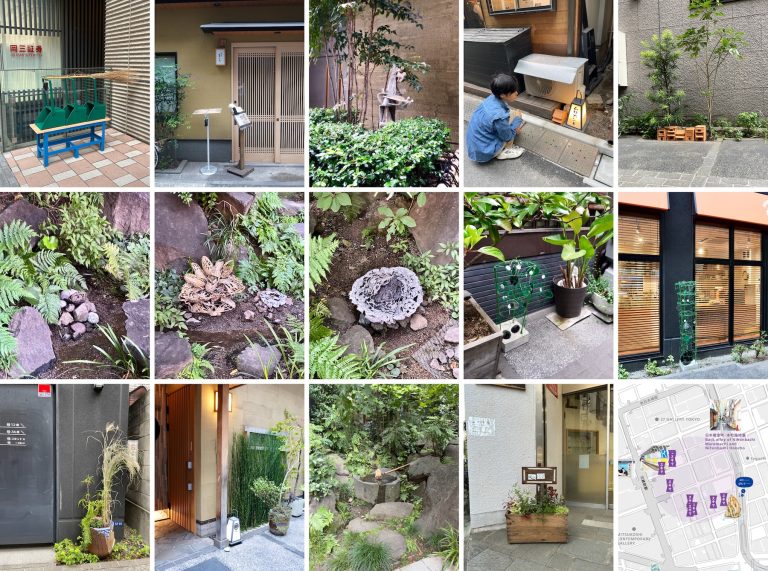
This project is an attempt to grasp the structure of the city from the perspective of its physical and conceptual “gaps,” and to utilize these small spaces between buildings as places for presenting artworks or as artworks themselves. This is a legendary project that Masato Nakamura, along with his artist initiative commandN, carried out in 1999. For the biennale, sculptures by artists that mimic potted plants will seemingly thread these gaps of back alleys together to enrich the city’s marginal spaces.
Sponsor: Mitsui Fudosan Co., Ltd.
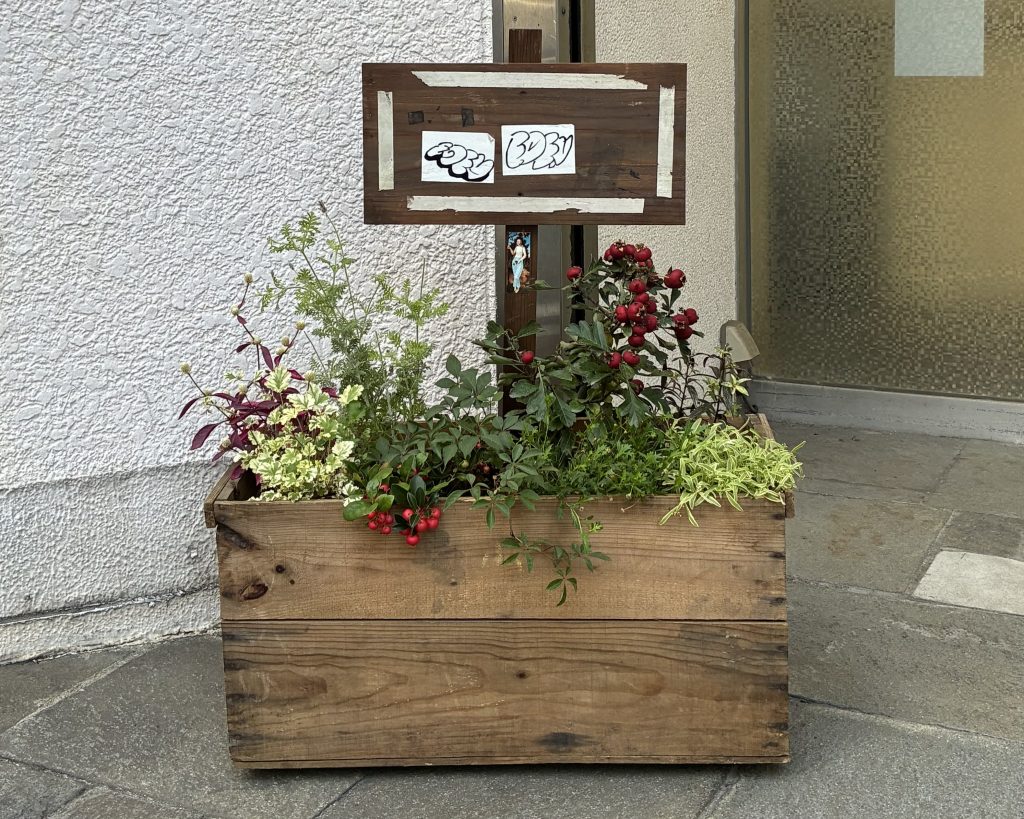
* This work is exhibited near the entrance of the Etoile Kaito Living Building.
Click here for the audio guide
In my daily life, I find beauty in the posters, lettering, and traces of street art on signboards, and in the way they gradually fade over time. These surfaces bear the marks of human actions and sometimes possess a charm that evokes art history. Their colors can resemble abstract paintings, and the layered acts of pasting, painting, peeling, and erasing recall the technique of décollage—unconsciously creating a single image. While some may see this as mere “dirt,” if such signboards were displayed in a museum, people might observe them with care and even find beauty in them.
For this project, I place planters in the city with real flowers, accompanied by signboards whose worn surfaces are meticulously recreated in paint. Through this, I aim to express traces of action and unconscious layering using the medium of paint. I hope this small intervention, blending into the urban environment, will bring passersby a quiet sense of unease and a moment of discovery.
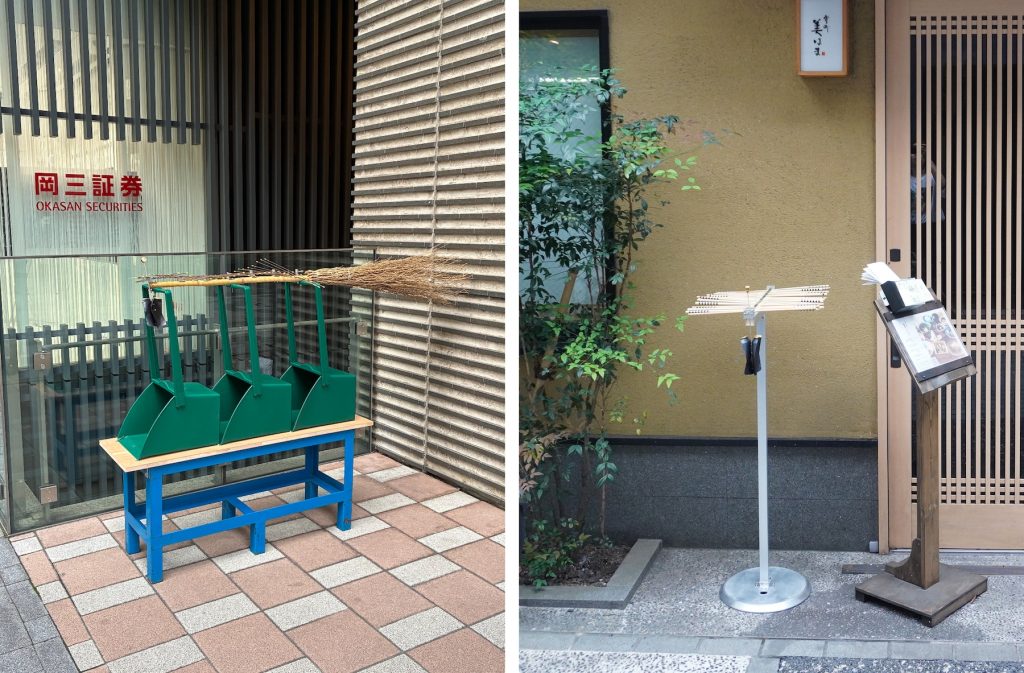
Click here for the audio guide
The potted plants sway, thin wires resonate. Their vibrating outlines trace the unseen shape of the wind, announcing the city’s breath.
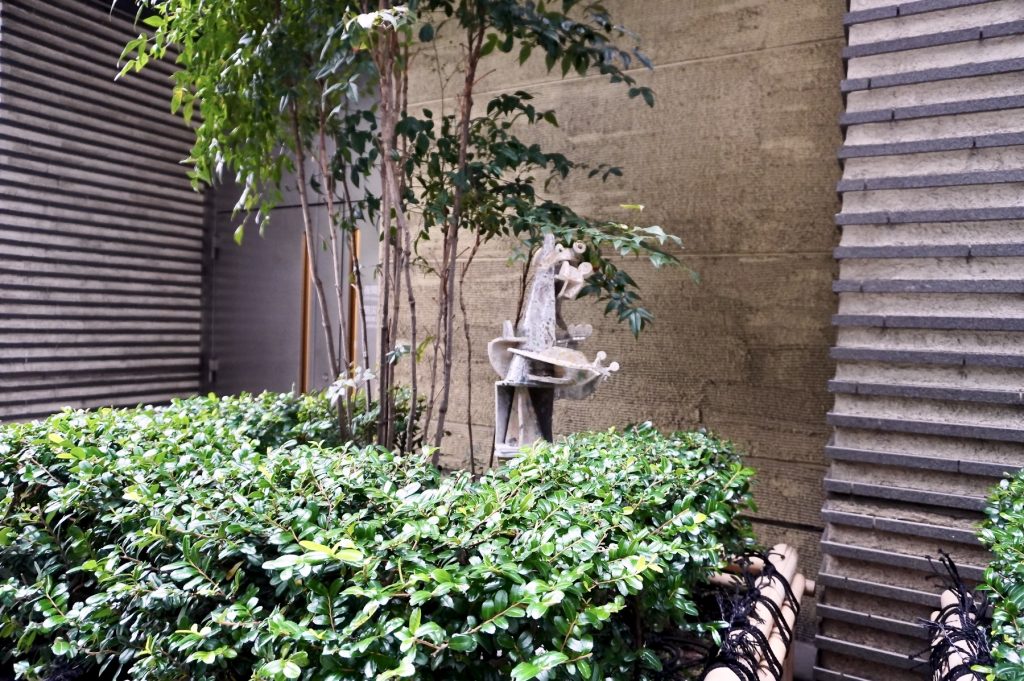
Click here for the audio guide
Once, the Japanese river otter (Nihon Kawauso) lived along the waterways of Japan, beloved by people, but it has since disappeared. Believed to be extinct, it now survives only in our memories, as a species lost from this world.
This work embodies the idea of an “unexpected encounter” — imagining what it would be like if, in the very heart of the city at Nihonbashi-Muromachi, near the Nihonbashi River, an otter were to suddenly appear from between the plantings. Through ceramic sculpture, the work seeks to summon the presence of nature hidden within the city, aiming for an imagined encounter with a life that has vanished.
When one unexpectedly meets the gaze of this small being, the everyday scenery of the city becomes imbued with stories that stretch from the present, back through Edo, and further into the past. I hope it offers an opportunity to reflect on our future, living together with nature.
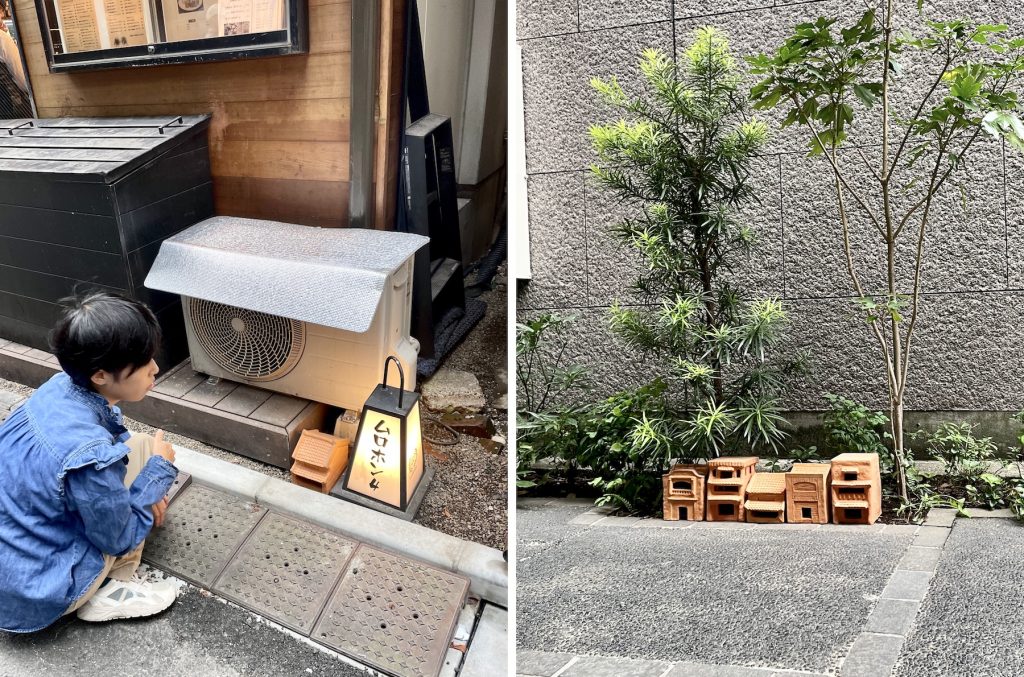
Click here for the audio guide
Urban development has resulted in transparent skyscrapers. Standing in the alleys within the town blocks, this place is relatively low and dark, and the area of Nihonbashi seems as if it has sunk to the depths of the earth. Nihonbashi has flourished as a hub of people and goods, which has continued to develop during the Meiji era.
However, experiencing the destruction around the last war, its historical appearance has changed significantly. Every place has its own path to where it is today, and it is impossible to describe its current state without that path. It is no longer possible to see the streetscape that was once called “the best in Japan,” but we can still find many gaps there created by the Edo land division existing even today, as it survives beyond human time. We are recalling the past by creating ceramic pieces in the shape of the buildings that once made up Nihonbashi and arranging them in various gaps in the town.
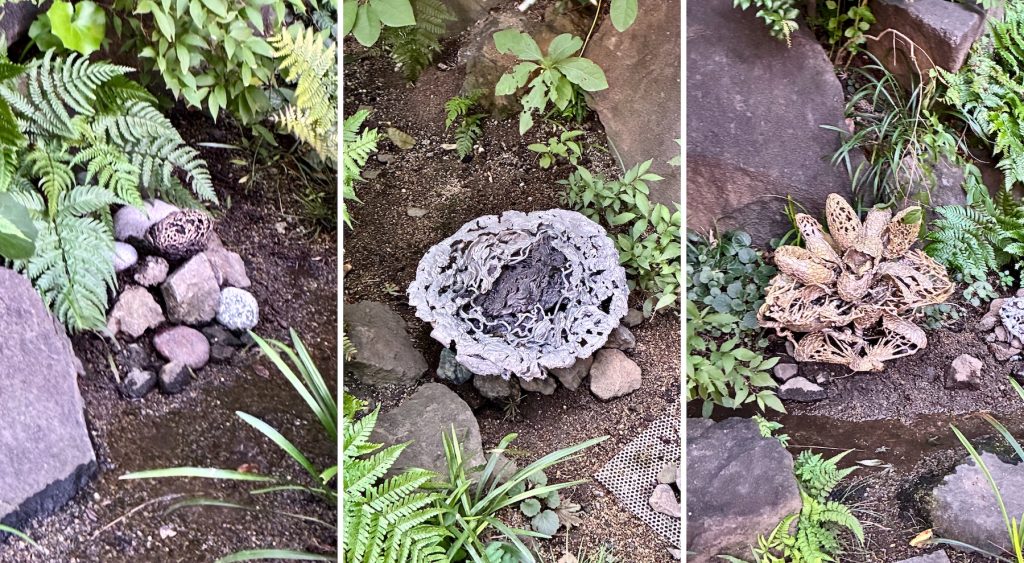
Click here for the audio guide
We casually place shiny small stone objects in the corners of parks and alleys, beside flowerpots, and in small stone hangouts. They look like “just stones,” but they have a shape and texture that is somehow intriguing, drawing in the viewer’s gaze to make them suddenly think, “Could it be…?”
“This could be a fossil of the eye of a Triceratops.”
This is the kind of artwork that gives room for imagination, reminding us of our childhood fantasies and idle conversations.
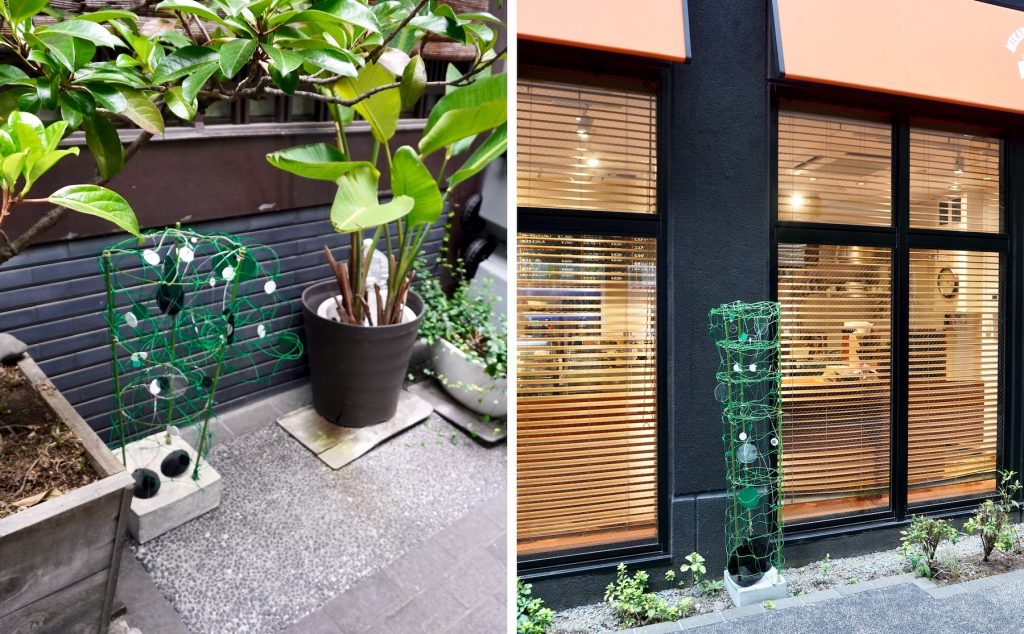
Click here for the audio guide
“Tokyo, Nihonbashi, the bread shop on Garigari Mountain, and Tsuneko-san climbing the stairs, ko-cho, ko-cho” (from a Japanese nursery rhyme).
The hands and arms have become the streetscape of Nihonbashi. Between the fingers are alleys. In the small alleys, potted plants grow together like downy hair. Upon closer inspection, eyes are emerging. Like pores glowing with moisture, they seem to gaze intently at us. To help nurture the downy hair, let us erect supports and cover them with netting. By cherishing the sprouts, we can see far into the distance. What can be seen from there? Where does this staircase of arms lead?
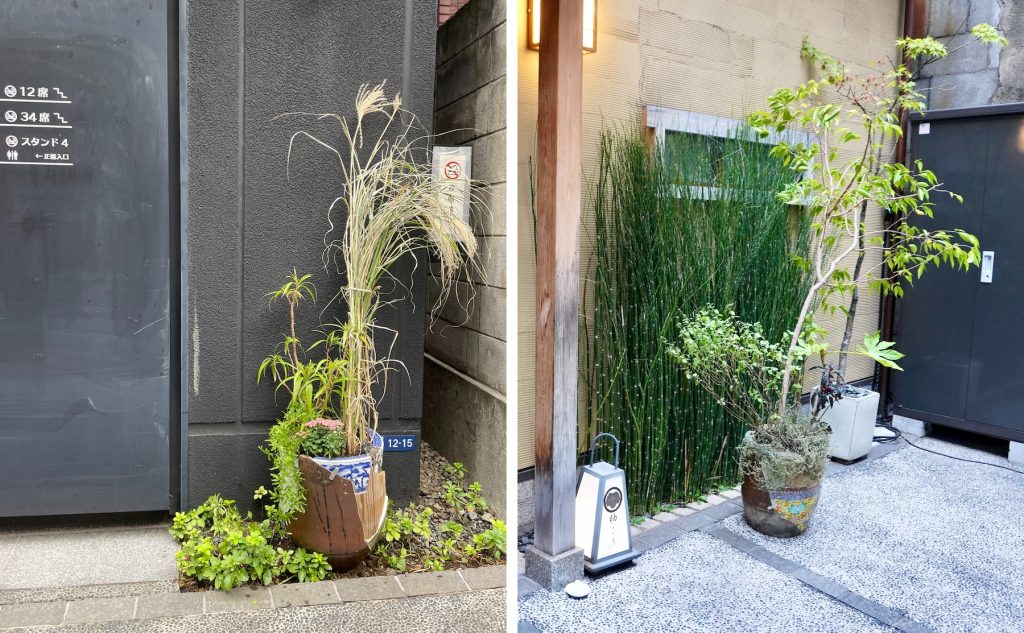
From left: Manyo Grass in Wild Ascent, The Untamed Fields: Plantation I (Countless grasses surge forth; the fields bow to none)
; Manyo Grass in Wild Ascent, Beyond the Walled Bounds: Plantation II
(Countless grasses surge forth; breaking free from the walled colony)
Click here for the audio guide
This work seeks to transpose the very existence of an alley into the form of a small potted plant.
It gathers the miscellaneous forms and layered histories that linger in the backstreets of downtown and reassembles them within a single pot, revealing a cross-section of the city that resists any unifying frame.
The pot interweaves restoration techniques such as kintsugi (gold joinery), kasugai-tsugi (staple joinery), and yobitsugi (patch joinery), suturing together fragments of ceramic, concrete, stone, plastic, and more. This mingling of materials and methods places fragments from different cultures and eras side by side, and moreover captures aspects of the city that slip through hegemonically prescribed orders of vision—moments found in the rhythms, modulations, and subtle fluctuations of cobblestones and louvers; the shadows beneath overpasses; or the drip edges that frame buildings.
The mixed planting brings together ornamental imports, native species, their hybrids, and even plants commonly called weeds.
In the midst of competition, they display brief moments of coexistence, embodying the untamed wildness of a living back alley—remaining resistant to domestication.
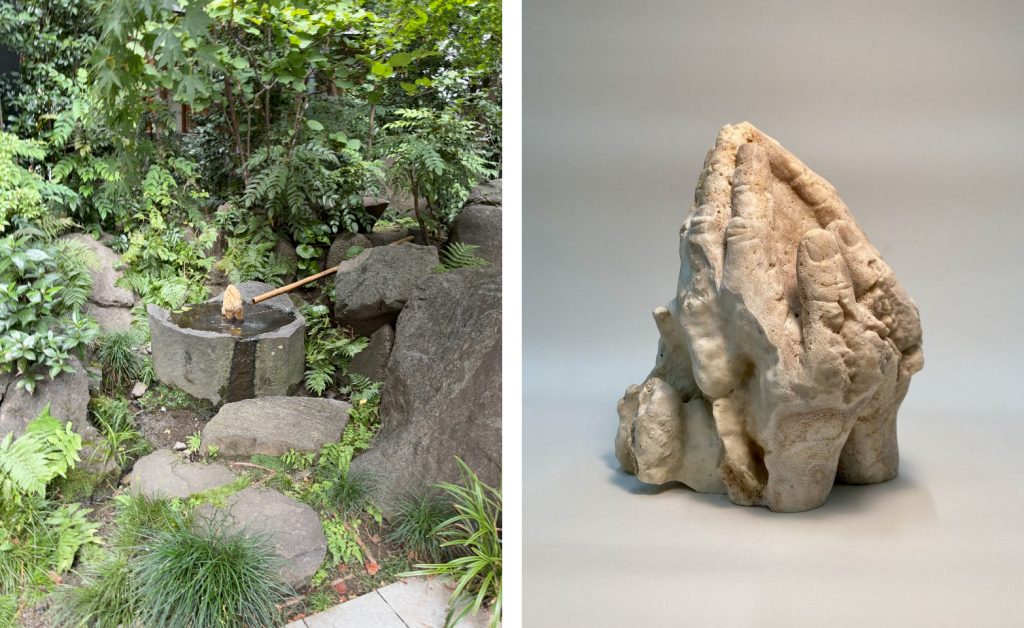
Click here for the audio guide
Map
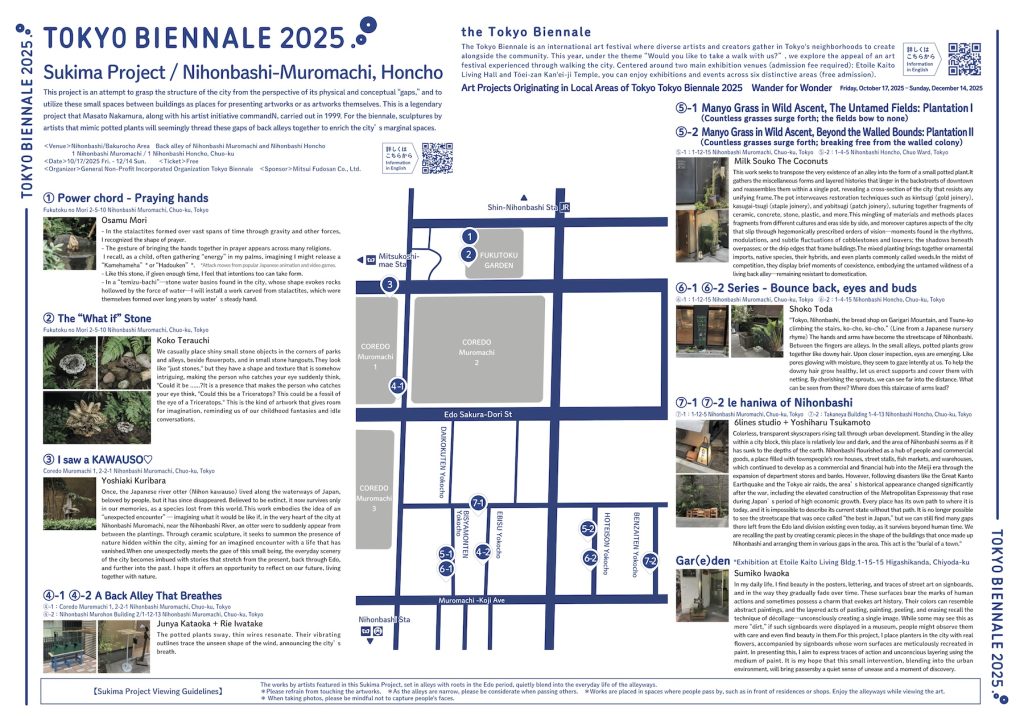
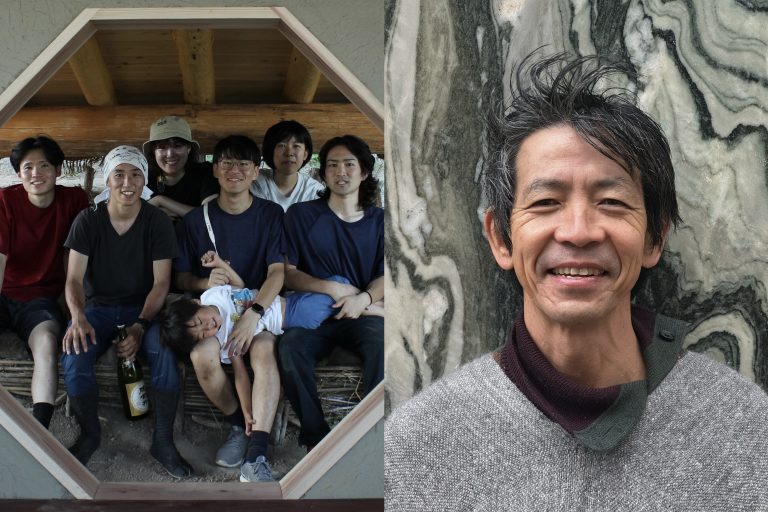
A collaborative project between Yoshiharu Tsukamoto; professor of architecture at Institute of Science Tokyo (formerly Tokyo Institute of Technology) and co-founder of Atelier Bow-Wow and 6lines studio; an architecture collective consisting of Ryo Oyama, Kaho Katayama, Sho Sasaki, Tsuyoshi Fuchino, Yukako Masui, and Riku Miyazaki, all from Tsukamoto Laboratory. The six joined the satoyama revitalization activities, which Tsukamoto has been working on since 2019 as one of the directors of the general incorporated association “Small Earth,” and they started working as 6lines studio with the construction of “Tiny House TEKITEKI-AN.”
Nihonbashi/Bakurocho Area
Back alley of Nihonbashi Muromachi and Nihonbashi Honcho
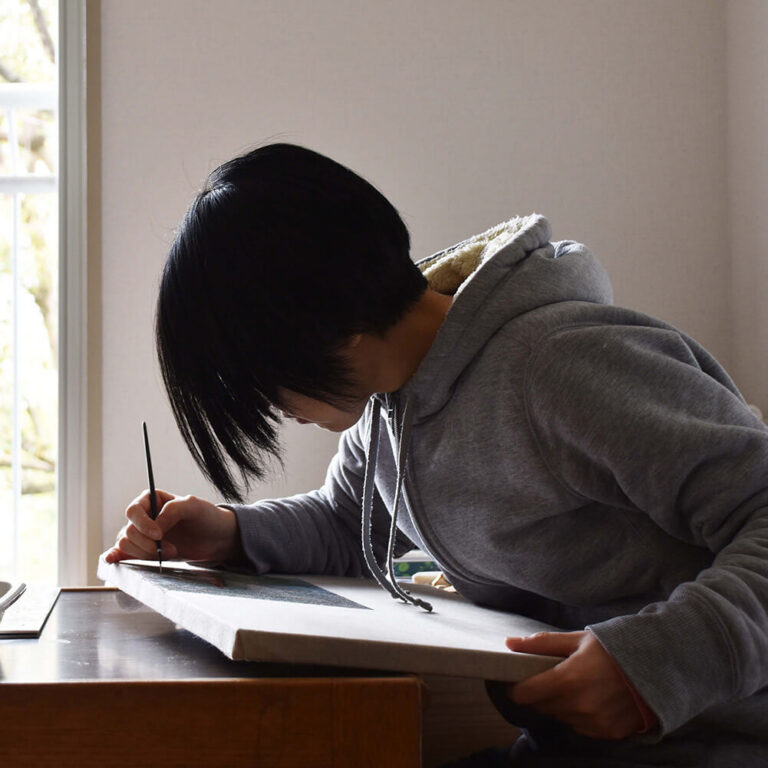
Born in Chiba Prefecture. Completed MFA in Fine Arts at Tokyo University of the Arts in 2009. Creates collages and oil paintings that combine figures cut out from Western masterpieces with contemporary landscapes, such as in the Time Leap Series. Recent solo exhibitions include Walking through Nakanoshima (YOD Gallery, Osaka, 2022) and Landscape (Oakwood Apartments Roppongi Central, Tokyo, 2020). Selected for the WATOWA ART AWARD (2021), Shell Art Award (2020), and the 15th TAGBOAT AWARD (2020).
Nihonbashi/Bakurocho Area
Etoile Kaito Living Bldg.

They create kinetic works that recreate small, everyday occurrences through simple phenomena, as well as works that gently resonate through a method of storytelling born from the encounters between materials and motifs.
Their major solo exhibitions include Iwatake Rie + Kataoka Junya, and the Museum Collection: An Illustrated Guide for Gravity and Materials (The Museum of Modern Art, Kamakura & Hayama, Kamakura Annex, 2025) and Big Two-Hearted River (3331 Arts Chiyoda, 2019). They have also participated in group exhibitions such as MOT Collection 30th Anniversary Exhibit: Nine Profiles: 1935→2025 (Museum of Contemporary Art Tokyo, 2025), Setouchi Triennale 2022, and BankART Bank Under 35 (BankART Studio NYK, Kanagawa, 2017).
Nihonbashi/Bakurocho Area
Back alley of Nihonbashi Muromachi and Nihonbashi Honcho
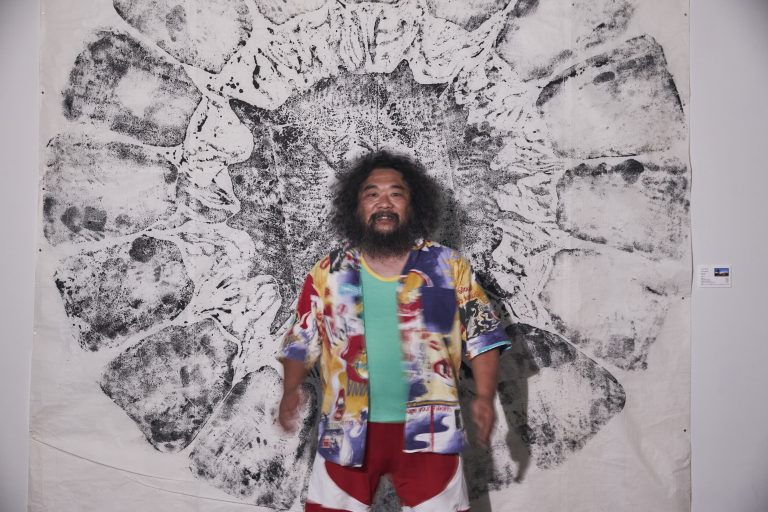
Born in 1980 in Gunma Prefecture, he believes that an artist should embody freedom and continues to create ambitiously across various media, including sculpture and painting, installation, video, performance, film, and workshops, without limiting himself to any specific style or mode of expression.
Nihonbashi/Bakurocho Area
Back alley of Nihonbashi Muromachi and Nihonbashi Honcho
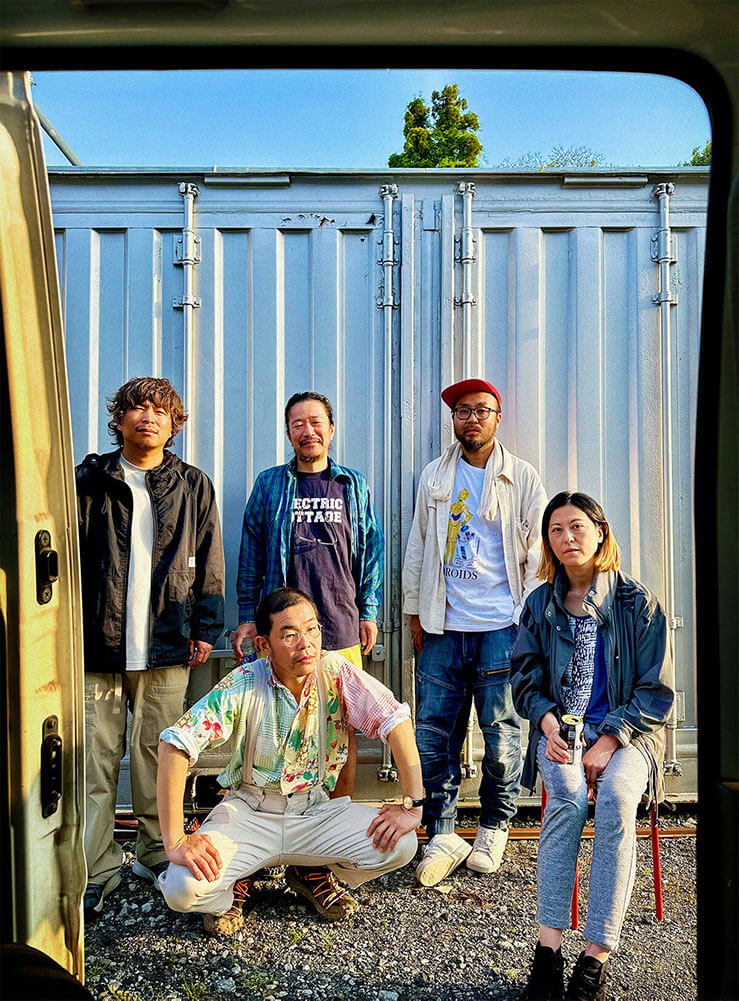
Photo by Azumi Kajiwara
Milk Souko The Coconuts is a collective of six artists: Naotaka Miyazaki, Naoki Matsumoto, Takuma Nishihama, Zenichi Tanakamaru, Ari Ookubo, and Hiroaki Takiguchi. Founded in 2009 as “Milk Warehouse,” the group evolved into “mirukusouko (Milk Warehouse) + The Coconuts,” and, with the addition of Ookubo in 2024, adopted its current name in 2025. Through bricolage-based modes of practice, the collective reconsiders the relationships between material and the body, as well as between consciousness and infrastructure. Major exhibitions include ‘Aichi Triennale 2022’ at Aichi Arts Center and ‘Plans for TOKYO 2019’ at gallery αM.
Nihonbashi/Bakurocho Area
Back alley of Nihonbashi Muromachi and Nihonbashi Honcho
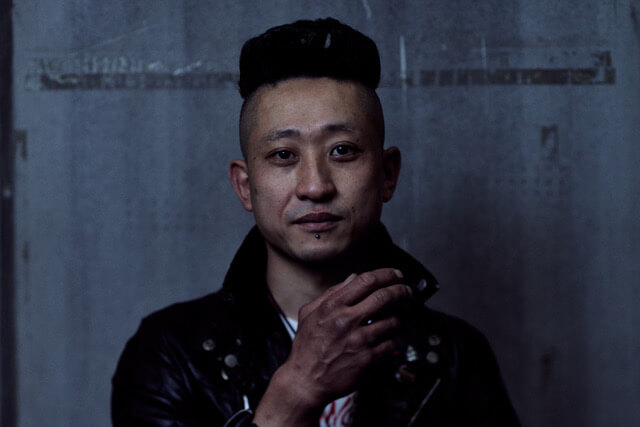
Photo by Keishin Nakaseko
In 2010, he held his first solo exhibition, Can’t Help Falling in Love, at the then Yamamoto Gendai. The following year, he participated in the Yokohama Triennale 2011: OUR MAGIC HOUR. In 2020, he presented a work featuring Elvis Presley reaching 4 meters tall at his first solo exhibition in ten years, Ba de ya (PARCEL, Tokyo). In 2022, he participated with a solo exhibition in the Asia Focus section of Frieze Seoul, hosted by PARCEL. In 2023, he took part in the NGV Triennale 2023 at the National Gallery of Victoria in Australia. In 2024, he will hold a solo exhibition at the Rokuzan Art Museum, located in the hometown of Rokuzan Ogiwara, a leading sculptor of the modern era. He is currently working on a piece exceeding 5 meters in height.
Nihonbashi/Bakurocho Area
Back alley of Nihonbashi Muromachi and Nihonbashi Honcho
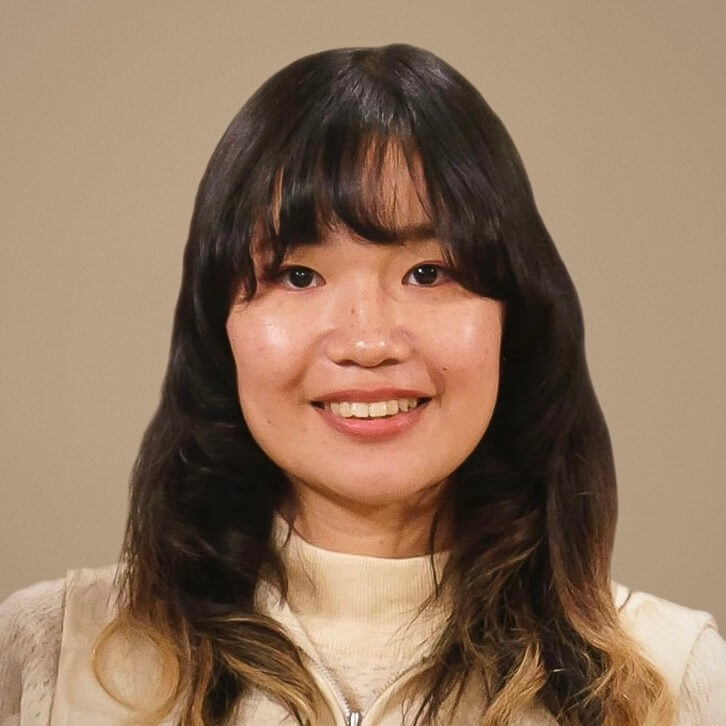
Using metal, Terauchi create works in which inner images and memories are deformed and intertwined with cities, natural objects, and personal belongings through the technique of metal casting. Major solo exhibitions include The Rendezvous with the Sensation (GINZA SIX, Ginza Tsutaya Books, Tokyo, 2024), Nendo no Heya (CREATIVE HUB UENO “es,” Tokyo, 2024), and JUMBLE DIVE (Bohemian’s Guild CAGE, Tokyo, 2023). Group exhibitions include the 71st Graduation Works Exhibition of Tokyo University of the Arts (The University Art Museum, Tokyo University of the Arts, 2023; Purchase Selection).
Nihonbashi/Bakurocho Area
Back alley of Nihonbashi Muromachi and Nihonbashi Honcho
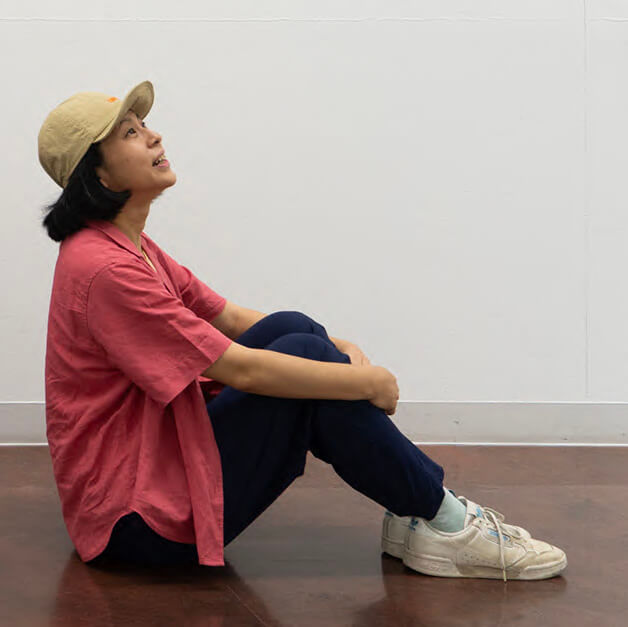
Born 1981 in Tokyo, Japan, Shoko Toda completed her master’s degree at Tokyo National University of Fine Arts and Music in 2006. She creates works based on the relationship between the body and landscape, using a method that combines video, sculpture, and drawing. Recently, she has been thinking about the flexible and interchangeable nature of existence that stretches and shrinks, appears and disappears. Solo exhibitions include Flowers, Horses, Conversation (Art Center Ongoing, Tokyo, 2024); exhibitions include Setouchi International Art Festival (Awashima, Kagawa, 2013 and 2016).
Nihonbashi/Bakurocho Area
Back alley of Nihonbashi Muromachi and Nihonbashi Honcho